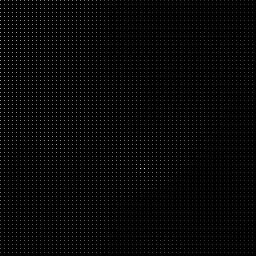Demo Script
Reading and ROI selection
DFT
The DFT of the small image is taken and its spectrum displayed
>>> import Numeric, FFT
>>> fd = froi.astype(Numeric.Float)
>>> F = FFT.fft2d(fd)
>>> iashow(froi)
(64, 64) Min= 38 Max= 255 Mean=82.117 Std=29.83
>>> iashow(iadftview(F))
(64, 64) Min= 23 Max= 254 Mean=103.943 Std=22.48
 |
 |
|
| froi | iadftview(F) |
Expansion by 4 without interpolation
DFT of the expansion without interpolation
Using the expansion propertie of the DFT (only valid for the discrete case), the resulting DFT is a periodical replication of the original DFT.
>>> fdx4 = fx4.astype(Numeric.Float)
>>> Fx4 = FFT.fft2d(fdx4)
>>> iashow(fx4)
(256, 256) Min= 0 Max= 255 Mean=5.132 Std=21.23
>>> iashow(iadftview(Fx4))
(256, 256) Min= 23 Max= 254 Mean=103.943 Std=22.48
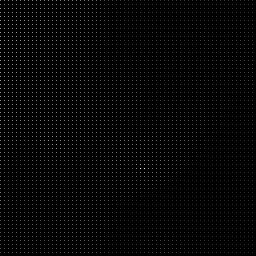 |
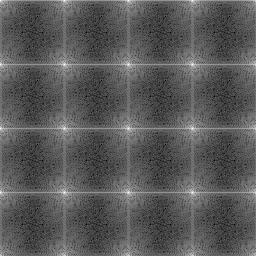 |
|
| fx4 | iadftview(Fx4) |
Filtering by mean filtering - nearest neighbor
Filtering the expanded image using an average filter of size 4x4 is equivalent of applying a nearest neighbor interpolator. The zero pixels are replaced by the nearest non-zero pixel. This is equivalent to interpolation by pixel replication.
>>> k = Numeric.ones((4,4))
>>> fx4nn = iapconv(fdx4, k)
>>> iashow(fx4)
(256, 256) Min= 0 Max= 255 Mean=5.132 Std=21.23
>>> iashow(fx4nn.astype(Numeric.Int))
(256, 256) Min= 38 Max= 255 Mean=82.117 Std=29.82
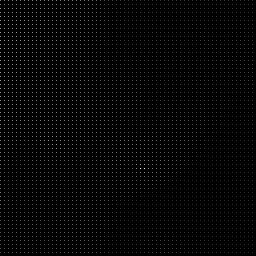 |
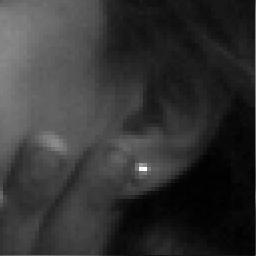 |
|
| fx4 | fx4nn.astype(Numeric.Int) |
Interpretation of the mean filtering in the frequency domain
Filtering by the average filter in space domain is equivalent to filter in the frequency domain by the sync filter.
>>> kzero = Numeric.zeros(fx4.shape)
>>> kzero[0:4,0:4] = k
>>> K = FFT.fft2d(kzero)
>>> iashow(iadftview(K))
(256, 256) Min= 0 Max= 255 Mean=83.562 Std=63.86
>>> Fx4nn = K * Fx4
>>> iashow(iadftview(Fx4nn))
(256, 256) Min= 0 Max= 255 Mean=84.113 Std=25.81
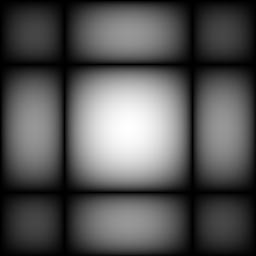 |
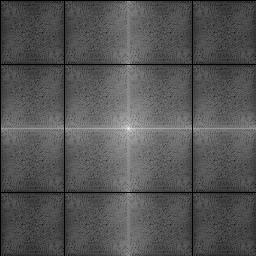 |
|
| iadftview(K) | iadftview(Fx4nn) |
Filtering by pyramidal kernel, linear interpolation
Filtering by a pyramidal kernel in space domain is equivalent to make a bi-linear interpolation. The zero pixels are replaced by a weighted sum of the neighbor pixels, the weight is inversely proportional to the non-zero pixel distance.
>>> klinear = Numeric.array([1,2,3,4,3,2,1])/4.
>>> k2dlinear = Numeric.matrixmultiply(Numeric.reshape(klinear, (7,1)), Numeric.reshape(klinear, (1,7)))
>>> fx4li = iapconv(fdx4, k2dlinear)
>>> iashow(fx4)
(256, 256) Min= 0 Max= 255 Mean=5.132 Std=21.23
>>> iashow(fx4li.astype(Numeric.Int))
(256, 256) Min= 38 Max= 255 Mean=81.746 Std=29.43
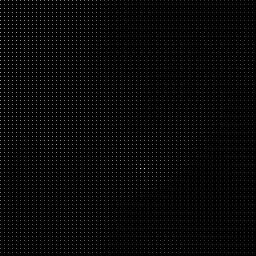 |
 |
|
| fx4 | fx4li.astype(Numeric.Int) |
Interpretation of the pyramid filtering in the frequency domain
Filtering by the pyramid filter in space domain is equivalent to filter in the frequency domain by the square of the sync filter.
>>> klizero = Numeric.zeros(fx4.shape).astype(Numeric.Float)
>>> klizero[0:7,0:7] = k2dlinear
>>> Klinear = FFT.fft2d(klizero)
>>> iashow(iadftview(Klinear))
(256, 256) Min= 0 Max= 255 Mean=33.597 Std=56.60
>>> Fx4li = Klinear * Fx4
>>> iashow(iadftview(Fx4li))
(256, 256) Min= 0 Max= 255 Mean=46.760 Std=35.63
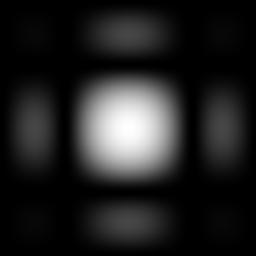 |
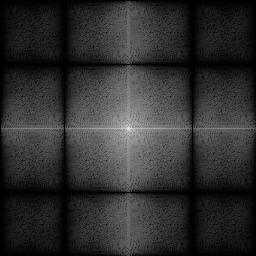 |
|
| iadftview(Klinear) | iadftview(Fx4li) |
Using an ideal filter
Filtering by cutoff period of 8
>>> H8 = iabwlp(fx4.shape, 8, 10000)
>>> iashow(iadftview(H8))
(256, 256) Min= 0 Max= 255 Mean=12.482 Std=55.01
>>> G8 = Fx4 * H8
>>> iashow(iadftview(G8))
(256, 256) Min= 0 Max= 254 Mean=5.354 Std=24.07
>>> g_ideal = FFT.inverse_fft2d(G8)
>>> print max(Numeric.ravel(g_ideal.imag))
2.96873389363e-014
>>> g_ideal = ianormalize(g_ideal.real, [0,255])
>>> iashow(g_ideal)
(256, 256) Min= 0.0 Max= 255.0 Mean=55.482 Std=31.85
 |
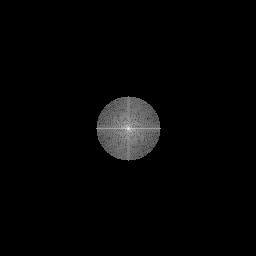 |
|
| iadftview(H8) | iadftview(G8) |
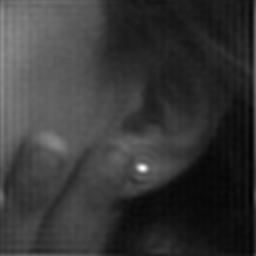 |
|
| g_ideal |
Using a Butterworth filter of order 5
Filtering by cutoff period of 8
>>> HB8 = iabwlp(fx4.shape, 8, 5)
>>> iashow(iadftview(HB8))
(256, 256) Min= 0 Max= 255 Mean=16.973 Std=56.38
>>> GB = Fx4 * HB8
>>> iashow(iadftview(GB))
(256, 256) Min= 0 Max= 254 Mean=11.519 Std=28.05
>>> g_b = FFT.inverse_fft2d(GB)
>>> print max(Numeric.ravel(g_b).imag)
3.19653155422e-014
>>> g_b = ianormalize(g_b.real, [0,255])
>>> iashow(g_b)
(256, 256) Min= 0.0 Max= 255.0 Mean=52.387 Std=31.15
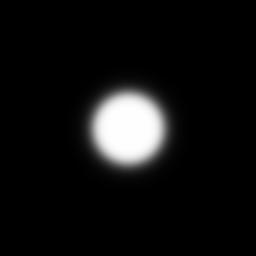 |
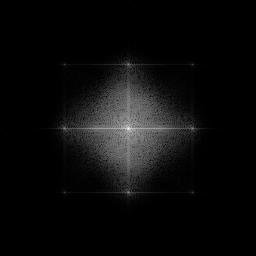 |
|
| iadftview(HB8) | iadftview(GB) |
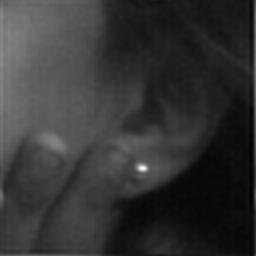 |
|
| g_b |
Display all four for comparison
Top-left: nearest neighbor, Top-right: linear, Bottom-left: ideal, Bottom-right: Butterworth
>>> aux1 = Numeric.concatenate((fx4nn[0:256,0:256], fx4li[0:256,0:256]), 1)
>>> aux2 = Numeric.concatenate((g_ideal, g_b), 1)
>>> iashow(Numeric.concatenate((aux1, aux2)))
(512, 512) Min= 0.0 Max= 255.0 Mean=68.026 Std=33.69
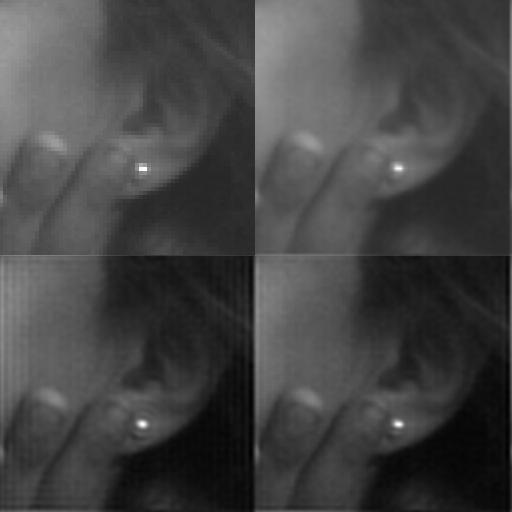 |
|
| Numeric.concatenate((aux1, aux2)) |



